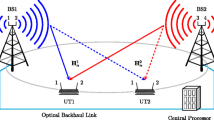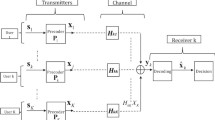Abstract
We study the problem of non-orthogonal spatial multiplexing under hard fairness constraints, assuming that the transmitter is equipped with multiple antennas and each of the independent receivers has a single antenna. Channel state information is available at the transmitter. All users are coupled by co-channel interference, thus maintaining individual QoS requirements requires the joint optimization of beamforming and power control. In this paper we study the problem in the absence of noise. The achievable signal-to-interference-ratios (SIR) of all user are limited by the amount of mutual cross-talk. The design question: at which level can the relative SIR levels be balanced under the given channel condition, and what are the optimal beamforming weights? Our approach is analytic. By exploiting the duality between uplink and downlink beamforming, we derive an iterative optimization scheme that is globally convergent and always finds the optimally balanced level. This provides a necessary and sufficient condition for the feasibility of the given scenario. Hence, the results will prove useful for the design of new beamforming algorithms as well as for new spectrally efficient resource allocation strategies.
Similar content being viewed by others
References
M. Bengtsson and B. Ottersten, “Optimal Downlink Beamforming Using Semidefinite Optimization”, in Proc. Annual Allerton Conf. on Commun., Control and Computing, Monticello, U.S.A., 1999, pp. 987–996.
M. Bengtsson and B. Ottersten, Handbook of Antennas in Wireless Communications, Chapt. Optimal and Suboptimal Transmit Beamforming, CRC Press, 2001.
H. Boche and M. Schubert, “Theoretical and Experimental Comparison of Optimization Criteria for Downlink Beamforming”, European Trans. on Telecomm. (ETT), Vol. 12, No. 5, pp. 417–426, 2001.
H. Boche and M. Schubert, “Optimum SIR Balancing Using Extended 1-Norm Beamforming Optimization”, in Proc. IEEE Internat. Conf. on Acoustics, Speech, and Signal Proc. (ICASSP), Orlando, U.S.A., 2002.
J.-H. Chang, L. Tassiulas and F. Rashid-Farrokhi, “Joint Transmitter Receiver Diversity for Efficient Space Division Multiaccess”, IEEE Trans. on Wireless Communications, Vol. 1, No. 1, pp. 16–27, 2002.
C. Farsakh and J.A. Nossek, “Spatial Covariance Based Downlink Beamforming in an SDMA Mobile Radio System”, IEEE Trans. on Communications, Vol. 46, No. 11, pp. 1497–1506, 1998.
D. Gerlach and A. Paulraj, “Base Station Transmitting Antenna Arrays for Multipath Environments”, Signal Processing (Elsevier Science), Vol. 54, pp. 59–73, 1996.
A. Lapidoth, “Nearest Neighbor Decoding for Additive Non-Gaussian Noise Channels”, IEEE Trans. on Information Theory, Vol. 42, No. 5, pp. 1520–1529, 1996.
C.D. Meyer, Matrix Analysis and Applied Linear Algebra, SIAM, 2000.
G. Montalbano and D.T.M. Slock (1998). “Matched Filter Bound Optimization for Multiuser Downlink Transmit Beamforming”. In Proc. IEEE ICUPC, Florence Italy, 1998.
R.A. Monzingo and T.W. Miller, Introduction to Adaptive Arrays, Wiley, New York, 1980.
F. Rashid-Farrokhi, K.J. Liu and L. Tassiulas, “Transmit Beamforming and Power Control for Cellular Wireless Systems”, IEEE Journal on Selected Areas in Comm., Vol. 16, No. 8, pp. 1437–1449, 1998.
M. Schubert and H. Boche, “SIR Balancing for Multiuser Downlink Beamforming – A Convergence Analysis”, in Proc. Internat. Conf. Comm. (ICC), New York, U.S.A., 2002a.
M. Schubert and H. Boche, “A Unifying Theory for Uplink and Downlink Multi-User Beamforming”, in Proc. IEEE Intern. Zurich Seminar, Zurich, Switzerland, 2002b.
E. Seneta, Non-Negative Matrices and Markov Chains, Springer, 1981.
E. Telatar, “Capacity of Multiple-Antenna Gaussian Channels”, European Trans. Telecommun., Vol. 10, pp. 585–595, 1999.
D. Tse and P. Viswanath, “Downlink-Uplink Duality and Effective Bandwidths”, in Proc. IEEE Int. Symp. on Inf. Theory (ISIT), Lausanne, Switzerland, 2002.
S. Vishwanath, N. Jindal and A. Goldsmith, “On the Capacity of Multiple Input Multiple Output Broadcast Channels”, in Proc. IEEE Int. Conf. on Comm. (ICC), 2001.
E. Visotsky and U. Madhow, “Optimum Beamforming Using Transmit Antenna Arrays”, in Proc. IEEE Vehicular Techn. Conf. (VTC), Houston, Texas, Spring 1999, Vol. 1, pp. 851–856.
J. Zander, “Performance of Optimum Transmitter Power Control in Cellular Radio Systems”, IEEE Trans. on Vehicular Technology, Vol. 41, No. 1, pp. 57–62, 1992.
J. Zander and M. Frodigh, “Comment on Performance of Optimum Transmitter Power Control in Cellular Radio Systems”, IEEE Trans. on Vehicular Technology, Vol. 43, No. 3, 1994.
J. Zander and S.-L. Kim, Radio Resource Management for Wireless Networks, Artech House, Boston, London, 2001.
Author information
Authors and Affiliations
Rights and permissions
About this article
Cite this article
Boche, H., Schubert, M. Optimal Multi-User Interference Balancing Using Transmit Beamforming. Wireless Personal Communications 26, 305–324 (2003). https://doi.org/10.1023/A:1025684624987
Issue Date:
DOI: https://doi.org/10.1023/A:1025684624987




